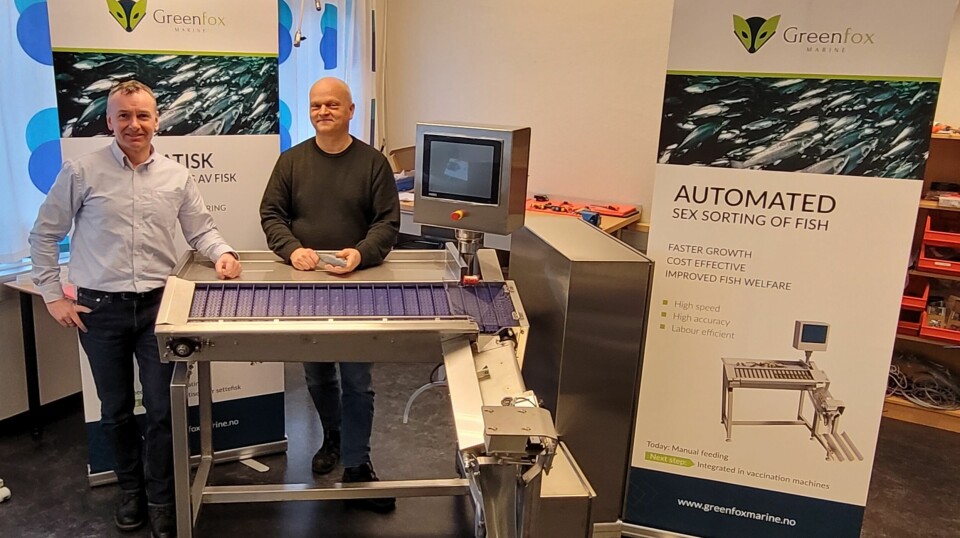
The joy of sex separation
Keeping male and female fish apart has several benefits including faster growth says company behind automatic gender sorter for smolts
A Norwegian company that has developed a system to automatically sort salmon by gender has been talking to fish farmers in the UK, the US, Canada, and Iceland.
Greenfox Marine explains on its website that there is great potential in sorting smolts into sex-separated cages, including faster growth for both sexes, where the male fish can reach harvest weight up to 3.5 months earlier than usual.
By using sex-separated cages, a more equal harvest weight is achieved for both female and male fish, Greenfox adds. Homogeneous harvest weight also offers advantages in processing.
Greenfox Marine is a spinoff from Greenfox Solutions, which offers control and monitoring solutions for industrial products and was founded by Roger Gullikstad, who also co-founded Aurotech Ultrasound, a company that developed an ultrasound scanner that is used, among other things, for open heart surgery worldwide.
Extensive experience
The Greenfox Marine team also includes automation entrepreneur Halvard Andresen, original founder of automated fish vaccination machine maker Maskon, which was recently acquired by aquaculture supplier ScaleAQ.
“Halvard Andresen has extensive experience in mechanics and automation,” Greenfox chief executive Erling Aspen told Fish Farming Expert’s Norwegian sister site, Kyst.no.
“We are technologists, but have had close cooperation with, among others, Maskon, Aquagen, [and] Mowi, and Aqua Kompetance are under way to ensure good operational solutions that safeguard fish welfare.”
99%-plus accuracy
Greenfox’s solution for automatic gender sorting of fish is based on scanning the fish with high-resolution ultrasound and the use of artificial intelligence. The AI model takes 0.05 seconds to analyse 32 ultrasound images of each fish, and the fish is then sorted into the desired channel.
“The machine has been operational since last summer and we have in the most recent tests, verified by customers, delivered an accuracy of over 99%. The first machine solution has a capacity of approximately 2,500 fish per hour, but we are now working on a solution to increase this significantly,” Aspen said.
Greenfox is now working to significantly increase capacity and has a partnership with Maskon to integrate its technology into Maskon’s vaccination machine.
“We have an exclusive collaboration with Maskon to get our technology integrated into their vaccination machine, where we will then be able to vaccinate and determine the sex of up to 40,000 fish per hour on the largest machines,” said Aspen. “Maskon has the world’s leading vaccination machine and vaccinated over 373 million fish last year.”
Cod
Greenfox has so far focused on salmon, but the company is also looking at integrating other functions and fish species. Sexual maturation of cod in pens can cause a problem, and sex sorting can be a solution to avoid this.
“Our existing machine solution should also be able to sort cod with a size between 80-120 grams. The gonads on the cod are in a different area of the fish, but there is flexibility to do that on today’s machine.”
Greenfox, based near Trondheim Airport, is not only looking at Norway for future opportunities.
Health index
“In Chile they sort by gender (manually with hand-held ultrasound equipment) approximately 50% of all hatchery fish today and the trend is increasing,” said Aspen. “They have done this for over 10 years, and it now amounts to over 100 million fish a year. At the same time as they carry out gender sorting, they also carry out a health check on the fish to sort for robustness.
“They examine, among other things, liver, kidney, and degree of sexual maturation. They scan these organs in the same area as we already do today for gender sorting. A further development of our solution will also be able to include a health index based on this. We are just starting out with a collaboration partner in Chile and have dialogue with major players in the USA, Canada, Iceland, and the UK.”






















































